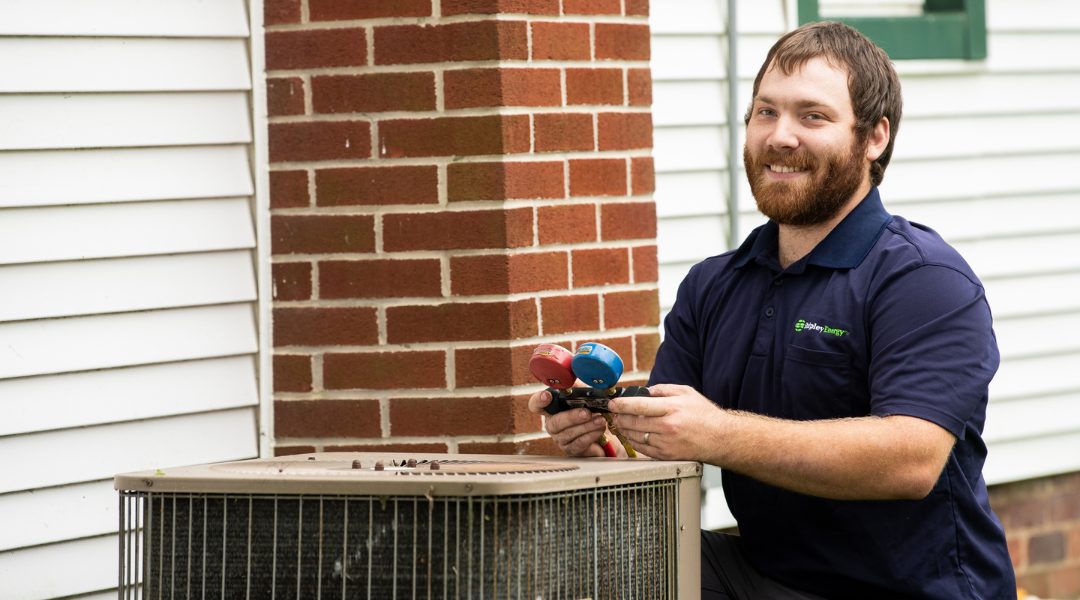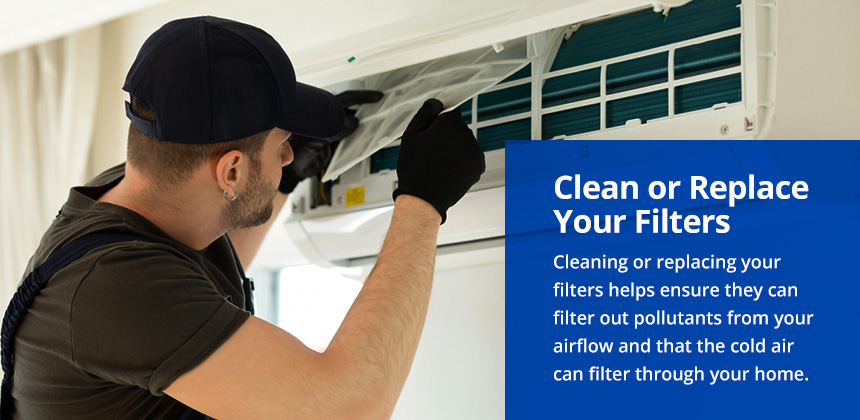
With warmer weather ahead, our daydreams start to shift focus to 90-degree weather, popsicles, and swimming pools. Then, reality hits. You suddenly remember the all-important and much-needed air conditioning tune-up on your “to-do” list.
• When Should You Start Preparing Your Air Conditioner?
• The Basic Components of an Air Conditioner
• 8 Tips for Getting Your Air Conditioner Ready for Summer
• Prioritize Safety
• Set Your Thermostat to the Right Starting Temperature
• Remove Obstructions
• Clean or Replace Your Filters
• Check Your Ductwork
• Clean Your Outdoor Unit
• Check Drainage Lines
• Consider Upgrading
• Get Your Air Conditioner Tuned-Up by a Professional
Temperatures are rising, and it’s time to consider turning on the AC. With your system lying dormant for six months, a few things can be easily done to ensure that your air conditioner is running properly.
You should start preparing your air conditioner when it’s warm enough to work outside and when any water you use outside won’t freeze. This is typically in the late spring or early summer, depending on how quickly it gets warm in your area.
Don’t wait until you need your air conditioner to start preparing it — you might discover issues that delay you from using it. Starting early and getting AC service before summer gives you enough time to call an HVAC technician if you find that you need a repair or need to replace specific components.
HVAC technicians get busy during summer with increasing summer AC maintenance and repair requests, so if you wait to prepare your air conditioner and schedule repairs, you could also have to wait until you can use your AC properly.
Air conditioning units contain two main parts — an exterior condenser and interior evaporators. These components are responsible for extracting heat from your home the same way a refrigerator keeps cold. Once the warm air is removed, cool air is pushed through the ductwork inside your home.
If you need extensive air conditioning system maintenance, it’s always best to contact a professional. However, there are specific maintenance and cleaning tasks you can do yourself to prepare your air conditioner for the summer.
Your air conditioner is essential for maintaining the comfort of your home, especially if you live in an area with intense heat or humidity. Use the following tips to prepare your air conditioner for summer so you can keep yourself and your family comfortable.
The first step is making sure you’re safe before you start working on your air conditioner. It’s extremely important to make sure the power is turned off to your condenser, which can be found on the service panel. Not doing so is extremely dangerous. If you’re not a licensed HVAC technician, you should avoid working on your air conditioner yourself and have a professional give your AC a tune-up.
Once everything is turned off, you still need to wait at least 30 minutes for the electrical charge in the capacitor to dissipate. Again, not doing so is extremely dangerous, as you could be electrocuted.
Many people don’t think of what to set their thermostat to when they first boot up their air conditioner. While it can be tempting to turn it all the way down to try and make your home cooler sooner, doing so doesn’t make your air conditioner work any faster. Instead, you should set your thermostat to a normal temperature.
Remember that lowering the temperature in your home won’t work unless you switch the setting to “cool.” If the cool air doesn’t kick in a few minutes after changing the setting, consider calling a service technician for repair.
The next step is to check your exterior unit for any obstructions limiting your airflow. This includes cutting back grass, hedges, or trees that could get in the way. It’s also common to find grass, leaves, or trash that should be removed by the condenser. Make sure the grills are clear, and you can also spray the coils off with a hose. If you’d like, you can also use a specialized brush to clean the fins.

Cleaning or replacing your filters helps ensure they can filter out pollutants from your airflow and that the cold air can filter through your home. Dirty air filters can make your air conditioning system less efficient and recirculate allergens dust into your home. You should check your air conditioning filters monthly to remove dust or debris.
Changing the air filter is as essential for your air conditioner as changing the oil is for your car. Put in a new filter at the start of summer and at least once every three months after that. If you live where it is windy or there is construction, or if you have allergies, you might need to change it more often.
Essentially, you’ll want to follow three basic steps, which include checking, cleaning, or replacing your filter. You can also choose to use specialty filters, which often have better durability.
Your ductwork helps deliver cool air into your home, so you don’t want it to leak into your attic before it can improve the comfort of your home. You should check your ductwork to see if you notice any holes where air can potentially escape.
Most homes use either flexible or metal ducts. Flexible ductwork is often used because it’s faster to install but doesn’t last as long. Metal ductwork lasts longer. If you have flexible ductwork and notice it’s leaking, it’s essential to replace it. Metal ductwork can be sealed with duct tape temporarily, but you should always contact a professional to repair your ductwork when possible.
Learning how to clean an AC unit outside is essential to keeping your unit working at peak efficiency. Outdoor units can develop a buildup of dirt or debris. This buildup can block your airflow, which forces your air conditioner to work harder, which can drive up your utility bills and reduce the efficiency of your unit.
Once each year, you’ll want to wash off debris, starting by turning off the power. You can rinse off your condenser unit with a garden hose. You’ll want to gently rinse between the metal fins on your condenser and collect any free water that has condensed on the unit.
To ensure your air conditioner is running smoothly, checking the drain line regularly is essential. This pipe or hose attached to your interior unit moves excess water away from the coils and into a drainage area. If the drain line is blocked, the water can back up into the system, causing damage and potentially expensive repairs. If you suspect the drain line is blocked, it’s crucial to call a professional technician for repair as soon as possible to prevent further damage.
You may want to consider upgrading your unit depending on its age or wear. There are always more efficient and cost-effective models showing up on the market every year. If you decide to upgrade, you’ll want to ensure you look for models with the Energy Star logo, as these models are made to be energy efficient. The right model can help you save on utility costs while providing superior cooling.
Ultimately, keeping your home cool and comfortable in any weather shouldn’t require a lot of worry or expense. And as the weather starts to warm up, there’s no better time to schedule an AC tune-up. Shipley Energy offers a thorough 16-point inspection to ensure your air conditioner operates at peak efficiency. One of our technicians will verify that all electrical and mechanical systems work correctly.
Experts suggest getting your air conditioner inspected annually. This helps reduce energy costs for you and can help ensure that your system runs longer and cleaner. Don’t risk an AC emergency in the middle of summer! Call us today at 855.573.7468 to schedule your annual maintenance tune-up.